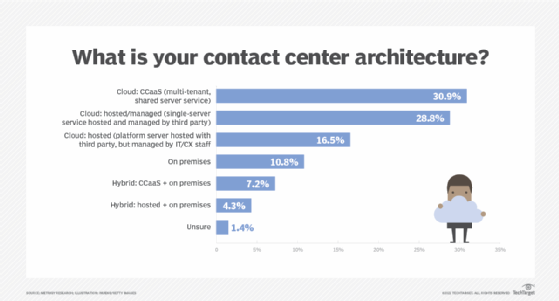What are the different types of contact centers?
Choosing the right type of contact center depends on understanding the options available and the needs of the organization.
As call centers have evolved into contact centers, the question of what kind of contact center an organization should use has become far more challenging.
Technologies such as chatbots are growing in popularity, but many organizations still rely on humans to help address a customer's concerns, needs and issues -- no matter the communication channel. Organizations must now consider which of the six popular contact center types best meets their needs and the needs of their customers.
The 6 types of contact centers
1. Inbound contact center
One of the most popular contact center types, an inbound contact center is built to handle incoming calls, typically for customer service and support. Usually, when a customer calls, they are first directed through an interactive-voice-response system that directs them to an automated message or the appropriate customer service agent to handle their query. Organizations such as banks, manufacturers and technology firms use inbound contact centers.
2. Outbound contact center
Outbound contact centers are staffed to reach existing clients or to generate new sales. Typical outbound contact center services include the following:
- conducting customer surveys
- billing outreach
- telemarketing and telesales
- market research
However, this type of contact center is likely to no longer be as effective as it once was. That's because an FTC regulation in the U.S. established the National Do Not Call Registry that makes it challenging to contact individuals who have not opted in for the service. Some outbound contact centers use social media, email or SMS as an alternative to traditional phone calls, but this approach is generally best handled by a multichannel contact center.

3. Multichannel contact center
As the reliance on telephones for communication has waned in favor of social media, SMS, email and online webchats, organizations needed to develop a new type of contact center. As its name implies, a multichannel contact center processes customers' requests and inquiries through multiple means of communication.
However, a multichannel center may only integrate with a few channels and not every available outlet. This setup can make it difficult to preserve the history of communications, and an agent may have to repeat previously answered questions -- a less-than-ideal customer experience.
4. Omnichannel contact center
Unlike a multichannel contact center, an omnichannel center allows a single agent to access every interaction with a given customer, regardless of their communication channel. This approach creates the highly sought-after personalized experience that is the new gold standard of customer service. However, while an omnichannel center can provide the best all-around service, it may be excessive for small or new businesses.
5. On-premises contact center
An on-premises contact center is built and managed by an organization and its IT team. It requires a significant upfront investment to establish the necessary hardware, software and infrastructure, and the deployment of any upgrades or maintenance. The benefits of this investment include more reliability, better overall call quality and a higher degree of security because the data remains on the organization's servers.
6. Cloud contact center
Unlike an on-premises contact center, a cloud contact center relies on a public cloud managed by a third-party vendor. The key benefits of this type of contact center include the ability to access and use the software regardless of an agent's location, little to no upgrade or maintenance costs and faster implementation because very little infrastructure and IT components are needed. However, the tradeoff to not managing the hardware or performing maintenance is a lack of control and customization for the systems in place.
How to choose the right type of contact center
Choosing a type of contact center begins with examining the product or service offered and the type of CX and service best suited to that product. From there, organizations can explore the functionality of each type of contact center and what tools and technology a contact center agent will need to use. Additionally, an organization will need to:
- define the contact center measurements and key performance indicators;
- perform cost analysis on an outsourced contact center vs. in-house; and
- determine the appropriate CRM and integrations needed to support capturing all customer communication data -- regardless of the channel.
Contact centers help organizations support their customers and prospective clients the moment a need or issue arises. As a result, the right contact center serves as a critical function that can make or break a customer's experience and overall satisfaction.








